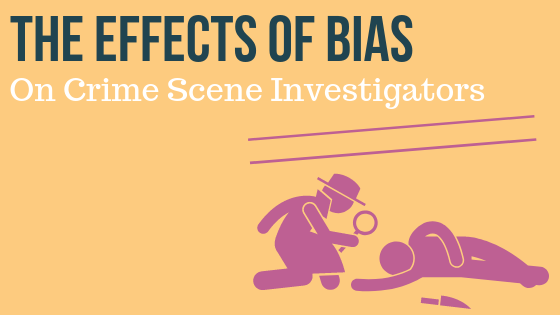As a crime scene investigator, it is nearly impossible to secure every item and trace from a crime scene, contrary to what television shows would lead you to believe. So which items would you prioritize? Would it depend on the type of crime committed? Perhaps contextual information, such as witness statements or leads would tell you which items were most important. Or maybe your level of expertise and familiarity within the role would factor in.
An important aspect of expert performance relates to biasability, which is the ability to make decisions based on relevant information without being biased by irrelevant information. Could an ‘expert’ or someone who had been performing a certain job for many years resist the biasing influence from contextual information better than novices? Ultimately, who would be better at filtering biases to collect forensic traces from a crime scene? That is the question that Claire A.J. van den Eeden et al set out to examine in their latest study.
Written by: Tara Luther, Promega
In order to find out, the researchers constructed a mock crime scene where a female mannequin had been hung in a stairwell. The crime scene was designed to be ambiguous, so that evidence could point to either a murder or suicide, though the crime was ultimately a murder designed to look like a suicide. The participants would not be allowed into the crime scene but were provided with a detailed panoramic view of the home that would allow them to detect small forensic traces. Would the participants be able to parse this out?
Participants in the study were divided into either an ‘expert’ group or a ‘novice’ group. Experts were defined as those who have experience in the field yet have no or limited knowledge of cognitive bias in forensic science. Novices who participated in the study were bachelor students in forensic science at a university of applied sciences, who were near the end of their 4-year education. While these students could potentially become crime scene investigators, they were also trained in laboratory work. They had participated in classes on cognitive mechanisms and bias but had no practical experience in the field.
They were further divided into groups of three, where one group received prior information that the victim had a history of depression and committed suicide, a second was told there were acounts of domestic violence at this residence and the victim had been murdered, and the third was given no prior information.
Each participant was asked to write down their initial impression of what had occurred, and their confidence with this impression. They were then given 30 minutes to look through the crime scene and ‘gather’ any evidence they deemed relevant. After their time was up, they were asked to record which traces they wanted to secure and why and were again asked what their impression was of the scene.
In all conditions, the majority of both experienced crime scene investigators and novices wrote down suicide as the most likely scenario when asked to give their first impression, however the students were much more confident than the experts in their assessment. After ‘processing’ the crime scene, participants changed their minds, with the majority believing a murder had been committed.
Perhaps not surprisingly, those who were in the murder group secured the most traces, followed by those in the control group, and lastly, those in the suicide group. There was no significant correlation between the number of traces gathered and the expertise of the participant, but students secured more crime-related traces than experts.
Based on this study, van den Eeden et al conclude that cognitive bias impacts novices and experts similarly, and that further training is needed. They admit that there is currently no evidence to show what an effective training would look like but note that awareness of bias doesn’t appear to be effective at preventing it, and that training should include solutions for those in the field.
WOULD YOU LIKE TO SEE MORE ARTICLES LIKE THIS? SUBSCRIBE TO THE ISHI BLOG BELOW!
SUBSCRIBE NOW!


